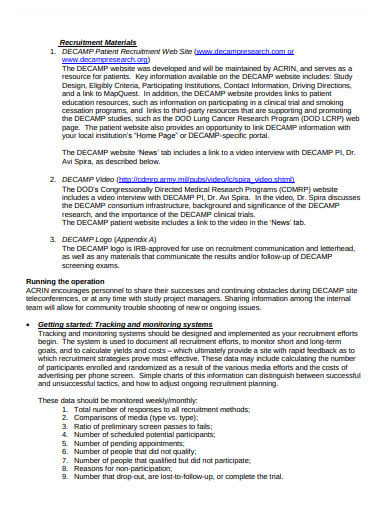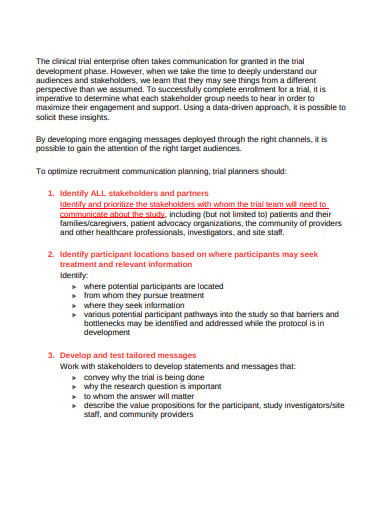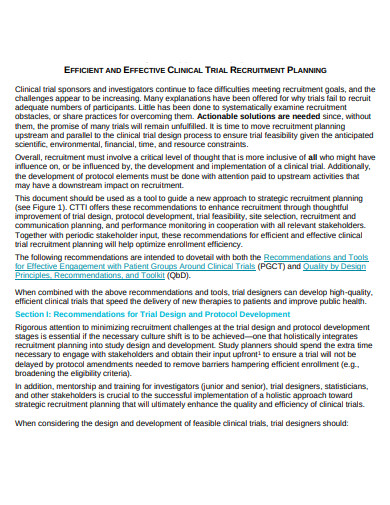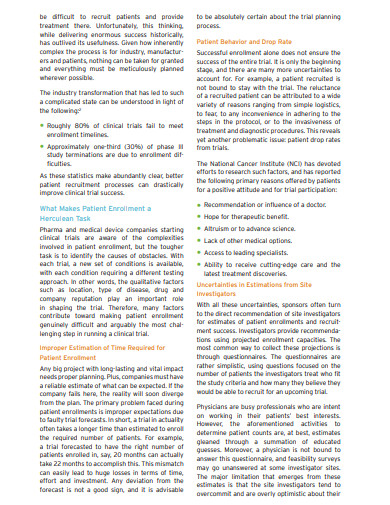
11+ School Counselor Lesson Plan Templates in PDF | Word
Empowering the youth to become the best can be such a fulfilling task to accomplish. But, school counselors proved that…
Jun 25, 2020
Clinical trial recruitments are considered to be very essential to the success of any clinical study and it is often considered to be complex and difficult parts of the clinical trial process. A clinical trial recruitment plan is generally made to minimize the risk and increase the likelihood of successful patient recruitment for a clinical trial. It is important to make a clinical trial recruitment plan as it helps in making all the arrangements and identifying alternate outreach channels.

 acrin.org
acrin.org contemporaryclinicaltrials.com
contemporaryclinicaltrials.com i-clinicaltrials.org
i-clinicaltrials.org ctti-clinicaltrials.org
ctti-clinicaltrials.org cognizant.com
cognizant.com isrreports.com
isrreports.comThe first thing that you must do is go through the patient nonprofits, message boards, support group websites as well as social media to learn more about the daily challenges experienced by the patients. You can start developing a list fo reasons that a patient may choose to join your clinical trial as you learn more about your patient population. You can also make a list of some potential barriers to participation like financial barriers, risks involved in the trial or logistical barriers.
After you have examined your audience, you can start thinking about which outreach mediums may be the best fit for your audience. Make sure that you also consider your budget and how much you plan to allocate to each medium.
After selecting your outreach mediums and have gathered knowledge about your audience, you can now make plans for your different tests that you are planning to run in the course of your campaigns. For instance, you may have made a list of the benefits related to joining your trial. You can create an ad copy that reflects different motivations, and then test them against each other based on that list.
Now it is time to start creating your outreach mediums so make sure you have done your research and try to use the same language that patients do when talking about their condition, rather than using medical technical language. Start applying your research to your design and image choices and be sure that your ads are reflecting your patient audience to help improve some engagement.
You must be prepared because even the best-laid out plan may get awry. Make sure that you have included backup approaches like different channels or alternative ad copy. You may want to consider at which point it may be helpful to engage the help of a clinical trial patient recruitment company, and also do some research a few different agencies in advance. There’s no doubt that patient recruitment can be a stressful process, but there is no harm in planning ahead of time as it prevents some delays and connects you with the patients interested in research.
The patient or the public are not given new tests and treatments as soon as they are made. Thes tests and treatments need to be studied minutely before applying them to the patients. A type of research that helps in studying a test or a treatment given to people is known as a clinical trial. Clinical trials generally study how safe and helpful are the tests and treatments After finding that they are safe and helpful, they may become a standard of care afterward.
There are several things that clinical trials can study. It studies new drugs that are not yet approved along with the new uses of drugs already approved and also studies new ways to give drugs. These trials must be carefully designed, reviewed, and properly completed. The person who is in charge of the trial is the principal investigator.
One of the widely recognized key determinants of success for clinical trials is patient recruitment. It includes a variety of services that are typically performed by the service providers to increase enrollment into clinical trials. There are still a substantial number of trials that fail to reach some of the retirement goals. There are some important effects on the stakeholders who directly contribute to the trial including investigators, sponsors, and study participants.
These are a few tips that will help you in creating a solid plan of action before you take on a study and recruit subjects.
The first step of recruitment planning is to gain a comprehensive understanding of the resources at your disposal. Overappraising your site’s capabilities and under-delivering on a study can harm your site’s reputation. Make sure you take time to inventory your equipment, staff and patient database to evaluate if the study is feasible for your site.
The success of any kind of promotion or advertisement depends on a company’s understanding of the target audience. Therefore, you must do some research on your ideal patient population. You must determine your population’s demographics, media usage, motivations and any other factor that may influence the course of your recruitment campaign.
Any patient recruitment campaign must begin with an internal focus. You must review your patient database and contact those who may be eligible. You can use phone calls, emails, postcards as well as social media to promote the study and recruit subjects from internal sources.
The sponsors commonly appreciate sites that exhaust the lowes-cost options before taking on more expensive initiatives. You can also take advantage of inexpensive community outreach events, networking, and physician referrals, etc.
A well-documented plan demonstrates accountability and a drive to succeed while working with a sponsor. Make sure you develop a well-written plan that specifically about your site that includes managing budgets and other estimated metrics.

Empowering the youth to become the best can be such a fulfilling task to accomplish. But, school counselors proved that…

A compensation plan is the detailed plan of an employee’s wages, salaries, benefits and the terms of payment. The plan…

As there is a saying that ” with big positions comes the big responsibilities”. It is the huge duty to…

The student recruitment plan is one of the most important and essential parts of educational institutions. The strategy interacts with…

The recruitment and retention are two different terms explaining the thing that is inter-related. Recruitment is the process of identifying,…

A College Recruitment Plan is the designed plan or a strategy that is developed to recruit the employees of a…

A Recruitment Action Plan is a strategy that is designed for putting the recruiting process into action. This is the…

A recruitment business plan is one of the necessities for a company. It does not just help you to map…

Clinical trial recruitments are considered to be very essential to the success of any clinical study and it is often…